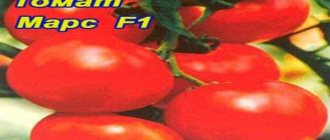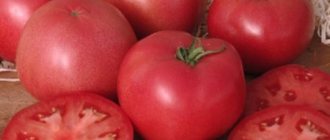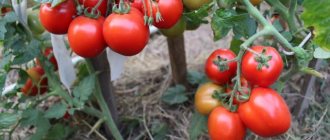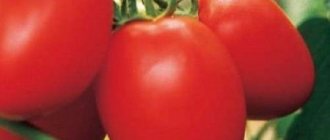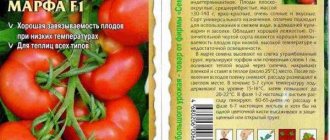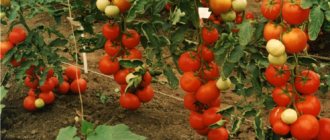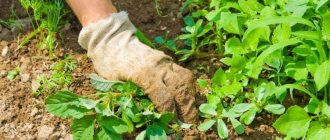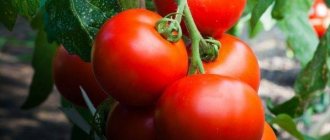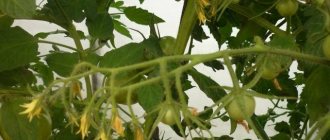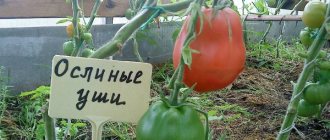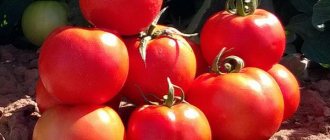General information about the plant
Tomatoes of the Vasily variety are distinguished by early harvest. Early ripening made it possible to grow the plant not only in the south of Russia, but also in the central zone of the country. Characteristics of tomato and external description of the plant:
- Hybrid variety.
- Standard.
- Early ripening, the berries are ready for picking 80–85 days after planting.
- Low-growing, the height of the bushes does not exceed 0.6 meters.
- Determinant.
- Good yield.
- Average foliage of bushes.
- Strongly corrugated green foliage.
- Compact.
- Erect stem.
- Medium branched.
- Powerful root system.
- Resistant to weather changes.
- Inflorescences of intermediate type.
- Immunity to most nightshade diseases.
- Long fruiting period.
- Simultaneous harvesting.
- Easy to care for.
- Well preserved.
- It is possible to transport tomatoes without losing their presentation.
The popular Vasily tomato variety is grown by Ukrainian and Moldavian gardeners. Reviews confirm the high percentage of tomato yield. The plant should be cultivated based on the climatic characteristics of the region. Most vegetable growers recommend the greenhouse growing method. Planting tomatoes in open ground is permissible provided that the climatic conditions are suitable for heat-loving plants. Technical data and external features of the fruit:
- Round shape.
- Red color when mature.
- Green color during ripening.
- Small size.
- Average weight is 100 grams.
- Smooth.
- Not prone to cracking.
- Sweet taste, no sourness.
- Juicy, not watery.
- Lasting aroma.
Tomato fruits are suitable for whole-fruit canning and pickling. The universal nature of the berry allows it to be used not only as preparations, but also consumed fresh. The fruits are used as an ingredient for salads and for self-consumption. Its small size makes the variety suitable for decorations and festive table decorations.
See also
Description and characteristics of the tomato variety King of Beauty Read
Hybrid Vasily
Vasily tomatoes are an amazing hybrid. Refers to low-growing, early-ripening, but abundantly productive varieties. As a rule, by mid-June the growth of each bush reaches 0.6 m, abundantly showered with smooth, medium-sized fruits.
The fruiting period is long, the harvest is extremely stable, which gives the agronomist a feeling of stability and reliability.
There are many high-yielding tomatoes, and this gives good opportunities to choose the best variety according to your needs.
Planting
When planting, it is necessary to adhere to hygiene rules, since the description of the Swat f1 tomato indicates that infection can reach the seeds through insufficiently carefully treated containers. It is also preferable to perform all work with gloves or wash your hands periodically.
Seeds for seedlings are planted between March 15–20 and March 30. No more than 60 days should pass before planting and before planting in the ground. Charcoal drainage and well-mixed seedling soil are poured into the container. Then the soil is moistened and holes 1 cm deep are made in it, at a distance of 3 cm from each other.
After the seeds are planted, they are covered with dry soil on top and removed to a warm place. The room temperature should be 28–30 °C.
Maintaining the temperature regime is extremely important, otherwise the seeds will rot or take a long time to germinate.
When the first shoots appear, the temperature drops to 15–18 °C during the day and 10–12 °C at night. After a week, the temperature rises again to 20–25 °C during the day, and 12–15 °C at night.
See also
The best and most productive varieties of tall tomatoes, when to plant them as seedlings Read
Cultivation Tips
The originator recommends the variety for seedling planting. Healthy seedlings are obtained by following simple rules:
- Plant seeds to a depth of 1–2 centimeters.
- Pre-moistening of universal soil for planting nightshade crops.
- Temperature conditions from 21 degrees.
- Timely watering with water at room temperature.
- A lighting source that organizes a 16-hour sunny day.
IMPORTANT! Hardening off seedlings before planting in open ground ensures better tomato yields.
Tomato Accordion
Accordion tomatoes belong to large-fruited and mid-early varieties. The duration of fruit formation and ripening varies from 107 to 110 days from the moment the plant emerges. The variety is intended for cultivation in open soil and in greenhouse conditions. The yield is high; as a rule, up to 5 kg of selected tomatoes can be harvested from one plant.
The height of the bush can reach up to 1.8 meters. To obtain the desired amount of harvest, it is necessary to form the plant into 2 stems.
The fruits are pear-shaped, their texture is ribbed, and when ripe they are colored pink-red. The weight of each fruit, depending on growing conditions, varies from 200 to 250 grams, the pulp is fleshy and aromatic. The taste is excellent. The pulp has a rich dark crimson color. The harvested crop of this variety is suitable for fresh consumption, as well as for the preparation of various juices, sauces and pastes.
Yield tomato Visibly-invisibly and other interesting varieties
Tomato Summer resident
photo by V. Medvedev
Description and characteristics of the tomato variety Dachnik, reviews, photos
An early, low-growing, productive, unpretentious tomato variety for open ground.
The bush is of a determinate type, 70-80 cm high. It is recommended to form it into 3-4 stems. The tomato sets fruit perfectly in any summer. The bush is simply strewn with fruits. The variety is early ripening, but bears fruit for a long time, yielding until September.
Basic qualities of fruits
The fruits are round, of medium density, red in color at ripeness, the taste is good, tomato with sourness. The weight of the fruit is usually about 100 grams, rarely up to 150 grams. These tomatoes are universally used - suitable for making juices and sauces, fresh and winter salads.
The Dachnik tomato variety is included in the State Register for the North Caucasus region for cultivation in open ground.
Features of growing tomatoes Summer resident, planting and care
We recommend sowing the seeds of this tomato variety for seedlings 55-60 days before the intended planting in the ground. Picking of seedlings is at the stage of two true leaves. Plants are planted in a permanent location when the threat of return frosts has passed.
Recommended planting pattern: 70 x 30 - 40 cm. Planting density: 6-8 plants per 1 sq.m.
It is recommended to plant tomatoes in open ground when the threat of return spring frosts has passed. If low temperatures are still expected after transplantation, place arcs over the plantings and cover the plants with agrofibre or film.
Further care for tomatoes consists of timely watering, fertilizing with complex mineral fertilizer, pinching and preventive measures to protect against diseases and pests.
Summer resident tomatoes on video
If you grew Dacha tomatoes, please write what the yield and taste of the fruit were in your climatic conditions. How do you rate the disease resistance of this variety? Would you grow these tomatoes again and would you recommend them to others? Briefly describe the advantages and disadvantages of this variety of tomatoes and evaluate its taste. If possible, attach to the comment a photo of the entire bush as a whole or individual fruits that you grew. Thank you!
Agricultural cultivation technology
To grow the crop, Asvon tomato seeds purchased at specialized sales points are used, because in the second generation the hybrid loses its varietal advantages.
Sowing seeds for seedlings is carried out in late February-early March in special containers with moistened soil. The planting is carried out to a depth of 1.5 cm and covered with film until the plants hatch.
After the formation of 1-2 true leaves, a dive is carried out. For this purpose, it is recommended to use peat pots, which will provide the opportunity for seedlings to adapt painlessly to a permanent place.
Planting material is transferred to greenhouses in early May. For open ground, this process is delayed until the end of the spring frost period. Harvest occurs in July.
See also
Characteristics of unusual tomatoes of the Danko variety and description of the fruits Read
Since the release of tomatoes from the bush occurs simultaneously, it is important to follow the planting rules. To do this, prepare the area and transfer the planting material into prepared holes with compost.
To get a high yield of tomatoes, you need to fertilize with complex fertilizers. Watering is carried out once every 10-14 days, with the drip irrigation method - once a week.
During the growing season, the recommended water consumption is 10-20 liters for each bush. To ensure a balance of moisture and air near the root system, periodic loosening of the soil is carried out.
To quickly ripen the crop, it is recommended to mulch the soil using grass, sawdust or black non-woven fiber. Tomatoes require regular feeding; nutrient deficiency negatively affects the yield and taste of tomatoes.
The plant is resistant to diseases, but during a late blight epidemic, it is recommended to treat the bushes with a mixture of slaked lime and copper sulfate. Control of biological pests involves the use of insecticides.
Pros and cons of the variety
In practice, it has been noted that fruits set equally well in hot weather and in bad weather. Tomato Niagara shows good yield - up to 10 or more kilograms of tomatoes per bush. During the season, summer residents pick a bucket of tomatoes from one bush in the greenhouse. Tomatoes on bushes will ripen in open ground and in greenhouses. Fruiting is extended - July, August, so you can take your time in harvesting.
The Niagara tomato has excellent immunity; there are no diseases on it, even if the fruits on bushes of other varieties are infected with blossom end rot or late blight. The absence of diseases saves the summer resident’s time on disease prevention and control and guarantees an environmentally friendly harvest without the use of chemicals. Niagara tomato fruits can be preserved until the new year. Their keeping quality is good. Tomatoes are not subject to rotting.
Now let's talk about the disadvantages, the variety has them:
- Seeds germinate poorly and take a long time. To speed up germination, you have to soak them in a growth stimulator or hydrogen peroxide.
- Tomatoes hold poorly on the hand and may fall off when the wind blows or accidentally touches a branch.
- Thin stems have difficulty holding the crop and require regular fixation on a support.
Advantages of the variety
Without knowing the characteristics of the Niagara tomato variety, it is difficult to decide to grow it. At least some information can be extracted from the description, reviews of gardeners and photos presented in the article:
- Niagara tomatoes, the photo of which is slightly below, are of medium early ripening. After sowing seeds for seedlings, it takes 100 to 120 days until the first fruits are harvested. Moreover, there is no difference whether you grow them in a greenhouse or open ground.
- Temperature changes do not have a negative effect on fruit set. Even in cold or hot summers, as noted in reviews of the Niagara tomato by gardeners who have been working with the variety for more than one year, the yield practically does not fall. According to gardeners, about 10 kg of smooth cream is harvested from one tall variety of Niagara tomato. Just look at the photo how the tomatoes grow together.
- Fruiting lasts for almost a month. The first fruits ripen in July, and the harvest can be harvested until mid-August. It is at this time that the peak of ripening occurs.
- Many diseases and pests are not terrible for the Niagara tomato. As a rule, there is no blossom end rot on fruits; late blight is also a harsh guest. Most often, this disease occurs in very rainy summers. And this cannot but please gardeners who dream of spending a minimum of time in their garden on care, and even more so on treating plants against diseases.
- Niagara has excellent keeping quality. The fruits retain their presentation and taste until the New Year holidays. Sometimes the top may dry out, but putrefactive processes do not develop.
- The Niagara tomato variety is unpretentious in care: watering, weeding, loosening and fertilizing are carried out in the same way as with other plants. For tall tomatoes, it is necessary to break off the lower leaves and shoots, leaving a stump of at least 1 cm.
- Seeds for seedlings are sown in March. When 2-3 true leaves appear, they dive. Seedlings are planted in open ground when stable positive temperatures have established, somewhere in late May or early June (depending on the region and climatic conditions of spring). To the greenhouse, naturally, early. The distance between bushes is 25-30 cm. This is enough for Niagara.
Minuses
We have practically found out the advantages of the Niagara variety, but we will also say about the disadvantages:
- Gardeners are disappointed by the low germination rate of seeds. Sometimes out of 10 seemingly healthy seeds, only one sprout appears. By soaking the seeds of the Niagara variety in a peroxide solution, you can slightly increase germination.
- Ripe fruits cannot hang on the brush for a long time and fall to the ground when blown by the wind or touched.
- Some vegetable growers cite the disadvantages of the Niagara tomato variety as the need to tie up the stems and trusses throughout the summer.
photo by Valentina Redko
Characteristics
The tomatoes are round-cuboidal, with slightly pronounced ribbing, shiny skin, which protects the fruit from cracking. The weight of tomatoes ranges from 70 to 100 g. The pulp is dense, the tomatoes hold their shape well. The taste is rich, sweet, without wateriness. High content of sugars and solids (up to 6%). The color of ripe tomatoes is bright red-pink, without green spots at the stalk.
You can compare the weight of this variety with others in the table below:
| Variety name | Fruit weight |
| Asvon | 70-100 grams |
| White filling | 100g |
| Ultra early maturing F1 | 100g |
| Striped chocolate | 500-1000 grams |
| Banana Orange | 100g |
| King of Siberia | 400-700 grams |
| Pink honey | 600-800 grams |
| Rosemary pound | 400-500 grams |
| Honey-sugar | 80-120 grams |
| Demidov | 80-120 grams |
| Dimensionless | up to 1000 grams |
Tomatoes are ideal for canning; the dense flesh does not crack; pickled or salted fruits look very elegant. It is possible to stuff, prepare salads or side dishes. The fruits are tasty fresh.
Granadero F1
This hybrid is classified as indeterminate. It is characterized by high productivity: if suitable conditions are met in a greenhouse, up to 16 kilograms of fruit can be harvested from one square meter! The vegetables have the same shape, they are plum-shaped, glossy, and medium-sized: the weight of one tomato is 100-150 grams. Vegetables tolerate transportation well, have an excellent presentation and a pronounced tomato taste. Tomatoes of this hybrid variety are suitable for preparing salads, and their neat shape and light weight make them ideal for preparing preparations!
Excavations in Buchenwald: researchers found 2 more bunkers, but no treasures there
I serve bright “boats” on the New Year’s table: it’s difficult to immediately understand what fruit they are from.
Kostomarov showed what kind of sport his daughter enjoys
The plant is not afraid of temperature fluctuations, and the variety is also resistant to Fusarium wilt.
Photo
The photo shows: tomatoes Timofey F1
Advantages and disadvantages
Among the main positive qualities of the hybrid variety “Timofey F1” are:
- tasty large fruits;
- unpretentiousness to the soil;
- resistance to lack of moisture;
- tolerance to temperature changes;
- disease resistance;
- good yield.
Among the disadvantages, it should be said that this species is quite capricious in terms of feeding. Gardeners also note that it does not get along well with other types of tomatoes.
Features of the variety
Sowing for seedlings in March-April. Dive in the phase of 2 true leaves. Among the features of Timofey F1 tomatoes, it is worth noting its resistance to cold. It must also be noted for its productivity and very high resistance to pest diseases.
Growing tomatoes Timofey F1
The plant is very tall and its trunk must be strengthened with tying, and its branches with supports. The bush is formed into 3-4 stems, usually three. At all stages of growth, it really needs complex feeding.
Care
Watering is carried out abundantly, but at a certain interval: once every 3-4 days. Feeding is carried out infrequently - once every 2 weeks. They should include alternating organic and mineral substances. Humus or wood ash is used as organic matter, and potassium, magnesium and nitrogen compounds are used as mineral fertilizers.
It is also important to regularly loosen the soil and remove all weeds and stones. Hill up the root system as necessary. The formation of the bush also takes place as needed. Tying up bushes is considered a mandatory requirement. It is best to remove the lower branches to allow more sunlight and moisture to enter. This will speed up the growth of the bush and the process of fruit formation.
Growing seedlings
When planting a crop, it is important to follow hygiene rules, as there is a possibility of infection reaching the seeds through the growing container. It is preferable to carry out all work when planting seeds with gloves, and wash your hands periodically.
Seeds for seedlings are sown in the second half of March 60 days before transplanting the plants to a permanent place. A layer of drainage is poured into the growing container.
For this purpose, you can use expanded clay or crushed charcoal. For planting, take a specially prepared soil mixture. You can simplify the process using a substrate, which is sold in stores.
The soil is lightly compacted, watered with warm water, holes are made 1 cm deep. The seeds are laid out at a distance of 3 cm from each other. The sowing is covered with a layer of dry soil, and the container is placed in a warm place.
See also
Characteristics of the ultra-early hybrid tomato Bulat and agricultural technology for growing the variety Read
To ensure the smooth emergence of seedlings, it is important to maintain the optimal air temperature at +28...+30 °C. Compliance with the temperature regime is required to accelerate the emergence of sprouts. Otherwise, the seeds will rot or the germination period will increase.
After the first shoots appear, lower the air temperature to +15...+18 °C during the day and +10...+12 °C at night. After 7 days, the air temperature is increased to +20...+25 °C during the day and +12...+15 °C at night.
The best varieties of tomatoes with descriptions
Before you accurately choose a variety or hybrid of tomatoes, you need to decide where exactly they will grow.
For open ground, low-growing varieties that will ripen early are more suitable. Mid-ripening species in good summer weather can produce a fairly good harvest, but they are susceptible to microflora, which can destroy most fruits.
It is customary to grow tall varieties and various hybrids in greenhouses. Here you can plant absolutely any tomatoes, even late-ripening ones.
The Summer Resident tomato is not young: it was registered in the State Register of the Russian Federation in 1999. The variety was obtained by specialists from the All-Russian Research Institute of Vegetable Growing; the originator was, among other things, the seed industry. At that time, there was no such wave of new varieties and hybrids, and each new product could be tracked by amateur gardeners.
The summer resident turned out to be a lifesaver for many enthusiasts, although it is officially approved for cultivation only in the North Caucasus region, of course, in open ground. Yes, it is not profitable to plant this tomato in a greenhouse: its bush is not tall, and a lot of free space will be wasted. But in those regions where tomatoes can grow without greenhouses, gardeners began to plant this variety with pleasure.
Brief description of the tomato variety Dachnik according to the State Register
The Dachnik variety is a representative of determinate tomatoes; its bushes rarely exceed the half-meter mark in height and practically do not require the formation or even tying of shoots. The bush is semi-spreading in shape, branching and foliage are at an average level. Leaves are of normal size and color. 4–5 fruits are formed in the cluster.
The summer resident’s bushes are small, but covered with fruits
In terms of ripening time, the variety is classified as an early ripening variety; the first fruits ripen approximately 100 days after germination. In the south, it is sometimes even considered ultra-early, although now there are many varieties that ripen a week or two earlier than Dachnik. The first wave of the harvest, lasting one and a half to two weeks, is the main one, then fruiting continues little by little until frost.
The fruits are medium-sized, round or flat-round in shape, scarlet or red in color, containing at least four seed nests. The weight is in the range of 50–100 g: tomatoes cannot be called leveled. The taste of fresh fruits is characterized as good, with a pronounced “tomato” aroma. The skin is thin, the pulp is medium dense. The main purpose is salad, but the size of the fruit allows them to be preserved as a whole.
Since at the time of its appearance the variety was recommended for commercial production, that is, for large agricultural enterprises, its tests were carried out not in small gardens, but in field conditions, where it showed good yield. In official documents it is given in terms of per hectare.
On average, the variety produces from 250 to 350 c/ha, which is at the level of standard commercial varieties. In the open ground, summer residents, with not very careful care, can harvest up to 4 kg of tomatoes per square meter. The possibility of industrial cultivation is based, among other things, on the good transportability of the crop. Fresh tomatoes can be stored for up to three weeks.
The variety is highly resistant to diseases, including fusarium and blossom end rot. Despite its regionalization in the south, it has good cold resistance. Since the bushes of this tomato are quite compact and stocky, it is often planted indoors, as well as on the balcony.
Features of cultivation
Sanded, treated or untreated hybrid seeds are available for sale. The processed ones are completely ready for sowing; no preliminary actions are required. Untreated Asvon tomato seeds must be kept in dissolved 1% potassium permanganate for 20-30 minutes, then washed and placed in a biostimulant solution for 15-20 hours. Epin or Humate are suitable for these purposes, a folk remedy is aloe juice with water. Sow the seeds immediately after they swell.
The soil should be loose, moderately saturated with moisture and oxygen. Recommended soil mixture for hybrid:
- Sand and humus (proportion 1:1).
- To improve the quality, ash is added to each bucket of this mixture.
- For further cultivation without picking, the seeds are planted in pots or cassettes, 2 seeds each.
- After germination, the second sprout is not pulled out, but cut under a stump.
Before sprouting, containers with seeds should be covered with a plastic bag and kept warm. After the sprouts appear, transfer to a windowsill (without a draft) or to a heated greenhouse. It should be warm here, but cool - this will not allow the seedlings to stretch out. Optimal temperatures are +20 degrees during the day and +17 at night.
Hybrid seedlings can be planted after 35-40 days. A prerequisite is a constant soil temperature of at least 15 degrees. Also, before planting, hardening of the sprouts is required: for 5-8 days you need to take the seedlings out into fresh air, gradually increasing the residence time.
Growing scheme (standard)
| Month | Kind of activity |
| March | Planting seeds |
| April May | The appearance of the first shoots, growth and hardening of seedlings |
| Mid to late May | Planting in open ground |
| June | Growing, care, feeding |
| July August | Harvesting |
Features of bush care
The variety does not require scrupulous complex care, but reacts sharply to the composition of the soil and fertilizing. The soil should be slightly acidified: for this in the fall you need to add humus or mullein (5 kg per 1 m2), then it is advisable to dig up the area. In the spring, before planting, it is recommended to saturate the soil with mineral complexes:
- superphosphate;
- wood ash;
- potassium sulfate.
During the growing season, apply root fertilizers and spray with minerals (urea, boric acid). A guarantee of a good harvest is regulated watering. Carry out as the soil dries. If watering is drip, once every 7 days is enough, if regular - once every 10-12 days. Under each root during the growth period you need to add 5-7 liters of water, during fruiting and ripening - 10-15 liters. After each watering, loosen the soil for better aeration. Mulch - grass, hay, husks - minimizes moisture evaporation.
Sources
- https://DachaMechty.ru/tomat/uborka/vasilij.html
- https://DachaMechty.ru/tomat/vyrashhivanie/svat.html
- https://1teplica.com/tomaty/reyting-urozhaynyih-tomatov-sorta-pozano-vasiliy-i-drugie
- https://MoeFermerstvo.ru/tomat/vyrashhivanie/svat
- https://MoeFermerstvo.ru/tomat/vyrashhivanie/asvon
- https://rusfermer.net/ogorod/plodovye-ovoshhi/tomat-pomidor/rannespelye-sorta/asvon-f1.html
- https://rusfermer.net/ogorod/plodovye-ovoshhi/tomat-pomidor/srednerannie-sorta/timofej-f1.html
- https://FermoVed.ru/pomidoryi/asvon.html
- https://prodachnika.com/ogorod/tomaty/asvon-podrobnaya-informatsiya-o-sorte.html
[collapse]
I. Hybrids
Hybrid tomatoes are virtually guaranteed to be resistant to diseases and bad weather conditions, which is something that non-hybrid varieties suffer from. Greenhouses and greenhouses are valued for storing heat, but in them tomatoes can suffer from too high temperatures and sudden temperature changes. In recent years, world selection has been aimed at producing “heat-resistant” hybrids with a reliable guarantee of ovary production.
Hybrids are especially helpful in a greenhouse or a small garden plot where there are no real opportunities for crop rotation and diseases are prevalent. Selection successes demonstrate confident resistance to various types of infections - viral (especially the most dangerous tobacco mosaic virus), fungal, bacterial. In addition, the hybrids have uniform fruits and consistently high yields.
Tomato Incas F1
One of the best hybrids for canning whole fruits without skin. Popular early high-yielding bush hybrid. The plant is medium-sized, compact.
Tomato from the Dutch company Numens, zoned in Russia; entered into the state register in 2000. Mid-early hybrid (105 days) of meter-high vegetables, determinate. Very high resistance to fungal diseases has been recorded. The fruits are 80-100 g, dense, bright red, pepper-shaped, fleshy, uniform, tolerate sunburn well, are very easy to ripen, transported over long distances without loss of quality.
Tomato Torquay F1
Dutch hybrid from Bejo Zaden; in the Russian register since 2007. Mid-season tomato (119-123 days from germination to ripening), bush type - determinate, maximum height 100 cm. Forms abundant multiple clusters with fruits weighing 60-140 g. Dense tomatoes withstand long-term transportation, excellent in pickling and pickling matters.
Tomato Mariana F1
The tomato was created in the French branch of the Japanese company Sakata (the image of the woman Mariana is a symbol of the French Republic). The breeders of this agricultural company are often suspected of producing GMOs, but so far without real evidence. Mariana is a mid-early determinate hybrid. The fruits are similar in shape to Incas - also elongated-oval, perfectly smooth, super dense.
Tomato Bagheera F1
Hybrid from the leading French seed company Cloz. Included in the Russian seed register in 2007.
Early high-yielding hybrids are a real boon for the garden. They are cold-resistant, do not need pinching or tying up, and practically do not get sick. The ripening period is marked as medium-early; determinate bush. The fruit is round, flattened on top, ribbed, weight ranges from 80-220 g. The hybrid is resistant to soil drought and nematode, more suitable for regions located in the south. Does not suffer from fusarium and verticillium wilt.
Tomato F1 Semko 2005
The tomato is suitable for open ground and under film shelters (greenhouses). Determinate, medium-sized, compact. Resistant to soil salinity, drought, high temperatures, grows well in open ground in both southern and northern regions. Vegetables practically do not suffer from viral and fungal diseases, even late blight.
Tomato F1 Semko 2010
Included in the state register in 2010. Ultra-early ripening determinate hybrid - 85-88 days pass from the sprouting of green vegetables to the coloring of fruits. The first brush is formed immediately after the sixth leaf grows. The fruits are incredibly dense for such an early tomato, and are by no means small - 130 g. The shape is round hearts with a beautiful pointed tip.
The newest indeterminate hybrid (on the register since 2015) - tested by us, everything is fine - created taking into account all possible greenhouse disasters. Firstly, it sets well even in the heat, as well as during temperature changes. Secondly, it is tolerant of problematic soil substrates. Thirdly, it shows high resistance to viral, fungal and bacterial infections.
The yield of vegetables varies between 20-30 kg/1 square meter. Mid-early hybrid (100 days from green shoots). The clusters begin to form after 7-9 leaves, each bears 5-6 tomatoes in the shape of rounded hearts, smooth, beautiful, attractive orange color. The weight of the “heart” is 160-190 g. The pulp contains a high percentage of dry matter, sugars, and carotenoids. The fruits are quite dense and do not wrinkle during transportation. Purpose: salad. Created as an orange variant of another hybrid - Tomato Pink Spama.
Bushes of unlimited growth, with dense foliage. Mandatory shaping is required, including a garter. Hybrid of medium early or medium ripening period (112-118 days). Clusters of 6-8 tomatoes weighing 130-150 g. The fruits are plum-shaped, slightly tapering downwards. They are deep red in color, thick-skinned, with a high percentage of dry matter.
Tomato Empire F1
Indeterminate hybrid of a new generation, in the state register since 2011. Medium-early (100 days - 2 days - from germination). The plant is tall, much taller than other types of tomatoes. Therefore, the tomato requires gartering and pinching. Tomatoes are oval-shaped with a spout, weight ranges from 80 to 140 g. On average, 9 kg are obtained per bush. The color of the fruit is red-orange. The skin and pulp are dense. Can be stored for 6-7 weeks. In greenhouses people do not suffer from viral and fungal infections.
On the register since 2015. The bushes are semi-determinate, beautiful, a meter and a half high. Suitable for any soil - open or closed. Plants require pinching. Multiple clusters bear up to 30 fruits with a sweet taste and a perfect “strawberry” shape. The weight is typical for classic cherry tomatoes - 25 g. Thanks to the strong skin, the fruits can be stored for a long time. Early hybrid: ripe fruits appear 91-93 days after the sprouts emerge. The plant is resistant to Fusarium wilt.
Tomato F1 Kaspar
The bush is short, usually up to the first cluster, 60 cm. The fruits of the plants are cylindrical with a spout, the length varies around 11 cm, and the weight is 95-115 g. They are very dense, without juice. It is convenient to pickle them assorted with cucumbers of a similar size.
The average ripening period is 115 days. The hybrid is intended for open ground, or is planted under low shelters; We plant three to four vegetable bushes per square.
Tomato Aunt Valya F1
Valya f1 tomatoes are early-ripening, tall hybrids with average yield. The bushes easily and quickly reach a height of 200 cm. In the register since 2015. Productivity is within 20 kg per square meter. On average, one bush produces 7 kg of tasty and beautiful tomatoes. Tomatoes ripen simultaneously, reaching 200-250 g in weight.
The fruits have a regular round, slightly oblong shape. The scope of use of tomatoes is very wide. Salads are prepared from the first fruits. As the volume of the harvest increases, the fruits are used for winter harvesting, as well as juices, ketchups, pastes, sauces and lecho. Tomatoes retain commercial quality for a long time and tolerate transportation and long-term storage well.
